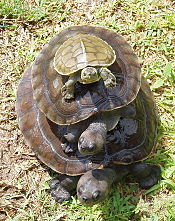Golden coin turtle

| |
| Scientific classification | |
| Kingdom: | |
| Phylum: | |
| Class: | |
| Order: | |
| Suborder: | |
| Superfamily: | |
| Family: | |
| Subfamily: | |
| Genus: | |
| Species: | C. trifasciata
|
| Binomial name | |
| Cuora trifasciata (Bell, 1825)
| |
| Synonyms | |
|
Sternothaerus trifasciatus Bell, 1825 | |
Golden coin turtle(Cuora trifasciata) or Chinese three-striped box turtle is a species of turtle endemic to southern China.

The species is distributed in China (Guangdong, Guangxi, Fujian, Hainan Provinces as well as Hong Kong). The populations from Lao People's Democratic Republic and Vietnam are now regarded a separate species, Vietnamese Three-striped Box Turtle (C. cyclornata).[1]
It hybridizes vigorously with its relatives in captivity and in the wild, and hybrids may be fertile. Several of these have been described as new species, such as the Fujian Pond Turtle ("Mauremys" × iversoni), a hybrid between (usually) males of this species and females of the Asian Yellow Pond Turtle (Mauremys mutica). In addition, the Golden Coin Turtle is suspected to be a parent of the supposed species Chinese False-eyed Turtle and Philippen's Striped Turtle.[2]
The species is considered Critically Endangered with extinction by the IUCN.[3] It is used in folk medicine,[4] e.g. as the key ingredient for the Chinese medicinal dessert guīlínggāo (龜苓膏); thus it is under threat because of unsustainable hunting. This is one of the most endangered turtle species in the world, according to a 2003 assessment by the IUCN.[citation needed]
Farming
C. trifasciata is raised on some of China's turtle farms. Based on the data from a large sample (almost one half of all registered turtle farms in the country), researchers estimated that the turtle farmers participating in the survey had the total herd of 115,900 turtles of this species; they sold 20,600 turtles of this species per year, with the estimated value of almost US $37 million. This would make a farm-raised C. trifasciata worth almost $1,800, making them by far the most expensive species tabulated in the survey. (By comparison, a common Pelodiscus sinensis raised for food would be worth under $7, and a Cuora mouhotii, sold for the pet trade, around $80.) Taking into account the registered farms that did not respond to the survey, as well as the unregistered producers, the total amounts must be significantly higher.[5]
The largest C. trifasciata farming operation is said to be located in Boluo County, Guangdong. According to the farm's founder Li Yi (李艺), the farm was started in 1989 with 8 wild turtles (2 males and 6 females) bought at a local market, and now has "over 2000" turtles.[6] According to the farm's site, captive-born turtles start breeding at 8 years of age.[7]
Footnotes
- ^ Blanck et al. (2006)
- ^ Parham et al. (2001), Buskirk et al. (2005)
- ^ ATTWG (2000)
- ^ da Nóbrega Alves et al. (2008)
- ^ Shi, Haitao; Parham, James F; Fan, Zhiyong; Hong, Meiling; Yin, Feng (2008-01-01), "Evidence for the massive scale of turtle farming in China", Oryx, vol. 42, Cambridge University Press, pp. 147–150, doi:10.1017/S0030605308000562, retrieved 2009-12-26
- ^ 财富人物:金钱龟"中国第一人" ("People and fortune: Country's No. 1 Golden-coin-turtle man") 2007-09-24 Template:Zh icon
- ^ Liyi Gold-coin Turtle Breeding Farm: Breeding and reporduction
References
- Template:IUCN2006 Listed as Critically Endangered (CR A1d+2d)
- Blanck, T., W.P. Mccord & M. Le (2006): On the Variability of Cuora trifasciata. Edition Chimaira. 153pp.
- Buskirk, James R.; Parham, James F. & Feldman, Chris R. (2005): On the hybridisation between two distantly related Asian turtles (Testudines: Sacalia × Mauremys). Salamandra 41: 21-26. PDF fulltext
- da Nóbrega Alves, Rômulo Romeu; da Silva Vieira; Washington Luiz & Gomes Santana, Gindomar (2008): Reptiles used in traditional folk medicine: conservation implications. Biodiversity and Conservation 17(8): 2037–2049. doi:10.1007/s10531-007-9305-0 (HTML abstract, PDF first page)
- Parham, James Ford; Simison, W. Brian; Kozak, Kenneth H.; Feldman, Chris R. & Shi, Haitao (2001): New Chinese turtles: endangered or invalid? A reassessment of two species using mitochondrial DNA, allozyme electrophoresis and known-locality specimens. Animal Conservation 4(4): 357–367. PDF fulltext Erratum: Animal Conservation 5(1): 86 HTML abstract


